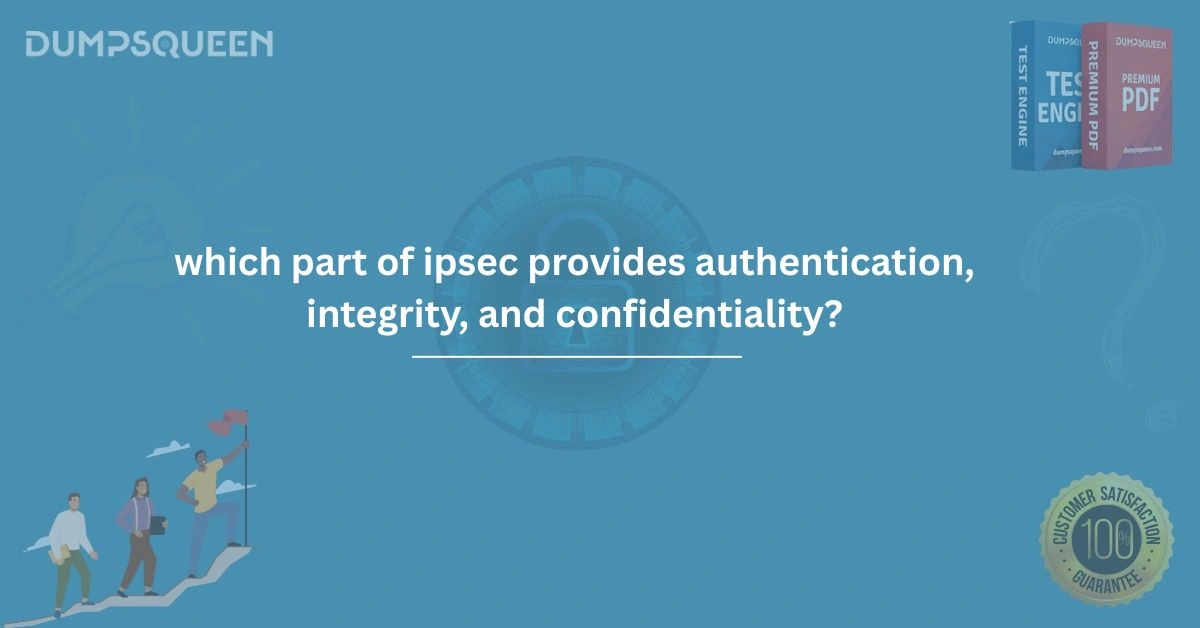Introduction
In today's networked world, securing communication channels is of utmost importance. Internet Protocol Security (IPSec) stands as one of the most robust protocols to safeguard data transmissions across potentially insecure networks, like the internet. IPSec offers a comprehensive framework for providing secure communication by ensuring that data packets are not only encrypted but also authenticated, ensuring integrity and confidentiality. One of the fundamental questions that arise when discussing IPSec's effectiveness is, "Which part of IPSec provides authentication, integrity, and confidentiality?" This article explores this essential question in-depth, examining how IPSec achieves these critical security goals. For those preparing for networking certifications like the Cisco CCNA, CompTIA Network+, and others, understanding the components of IPSec is crucial. The knowledge of how IPSec manages to secure data can be vital for acing your exams. So, let’s dive deep into the architecture of IPSec and understand how it provides security through authentication, integrity, and confidentiality.
Understanding IPSec
IPSec is a protocol suite that encrypts and authenticates data at the IP layer, ensuring secure communication between devices. It can be used in both IPv4 and IPv6 networks and is commonly deployed in Virtual Private Networks (VPNs), securing data transmissions between two endpoints over the internet. IPSec operates primarily in two modes: Transport Mode and Tunnel Mode, providing flexibility for various network security needs. The core purpose of IPSec is to ensure that data can be securely transmitted over an insecure network. However, achieving this level of security involves three main aspects: authentication, integrity, and confidentiality. These are essential security services that protect the data being transferred and validate the identity of the communicating parties. Understanding how IPSec delivers these services requires a detailed exploration of its key components.
Key Components of IPSec
To answer the question of which part of IPSec provides authentication, integrity, and confidentiality, it is essential to first understand the components that make up IPSec. These include:
-
Authentication Header (AH)
-
Encapsulating Security Payload (ESP)
-
Security Associations (SAs)
-
Key Exchange Protocols
These components work together to provide the three fundamental security properties: authentication, integrity, and confidentiality. Let’s break down each of them and see their role in ensuring secure communications.
Authentication Header (AH)
The Authentication Header (AH) is one of the primary components of IPSec. AH provides authentication for the IP packet by verifying that the data has not been altered in transit and that the data indeed comes from the claimed sender. It ensures data integrity and provides origin authentication by using cryptographic methods to secure the header of the packet. However, it does not provide encryption or confidentiality.
-
Authentication: AH uses a hashing algorithm (such as HMAC with MD5 or SHA) to generate a hash value of the packet's header and data. This hash value, called the Integrity Check Value (ICV), is included in the AH header. When the recipient receives the packet, it computes the hash on the received data and compares it with the ICV in the AH to verify integrity and authenticity.
-
Integrity: By including the ICV in the AH header, it guarantees that the packet has not been modified in transit. Any alteration in the data will cause the hash to mismatch, signaling potential tampering.
Despite its usefulness, AH does not provide confidentiality, which is why it is often used in conjunction with other parts of IPSec, like ESP.
Encapsulating Security Payload (ESP)
The Encapsulating Security Payload (ESP) is another crucial part of IPSec that is responsible for ensuring confidentiality along with authentication and integrity. While AH provides authentication and integrity, ESP adds the ability to encrypt the data to maintain confidentiality. This makes ESP the primary method for protecting the contents of IP packets in many IPSec implementations.
-
Confidentiality: ESP uses encryption algorithms such as AES (Advanced Encryption Standard) or 3DES (Triple DES) to encrypt the data in the IP packet. By doing so, it ensures that even if the packet is intercepted, the data remains unreadable to unauthorized parties.
-
Authentication and Integrity: Like AH, ESP also provides integrity and authentication features. However, in ESP, the entire payload (including the data and the packet header) is encrypted. ESP can also use the same hashing algorithms as AH (HMAC with MD5 or SHA) to provide data integrity and authentication.
Because of its ability to encrypt the payload and ensure integrity, ESP is widely used in VPNs, particularly in scenarios where confidentiality is critical. In fact, ESP is often used in conjunction with AH, especially in Tunnel Mode, where both the packet’s data and the header are encrypted, providing complete protection.
Security Associations (SAs)
A Security Association (SA) is a crucial concept in IPSec that defines the parameters and cryptographic keys used for securing communication between two parties. SAs play an essential role in IPSec’s ability to offer authentication, integrity, and confidentiality.
-
Configuration of Security Parameters: Each SA contains information about the encryption algorithms, key lengths, authentication methods, and other parameters. This configuration ensures that both parties can correctly encrypt, decrypt, and verify data.
-
Unidirectional Communication: SAs are unidirectional, meaning one SA is required for data going in one direction. For full two-way communication, two SAs are neededone for each direction. The SA ensures that both sides of a communication have agreed on how the data will be protected, including which algorithms will be used for encryption, authentication, and integrity.
Key Exchange Protocols
Key exchange protocols, such as Internet Key Exchange (IKE), are responsible for securely exchanging cryptographic keys between two devices. These protocols allow for the establishment of the necessary keys for encryption and authentication that are later used by the AH and ESP components.
-
IKE Phase 1: In this phase, the devices authenticate each other and establish a secure communication channel using Diffie-Hellman key exchange. Once the secure channel is established, the devices move on to IKE Phase 2.
-
IKE Phase 2: During this phase, the actual SAs are created, and the keys for encryption and authentication are exchanged. These keys are then used by AH and ESP to ensure the security of the communication.
Summary of Authentication, Integrity, and Confidentiality in IPSec
-
Authentication: Provided by both AH and ESP. The devices involved in communication can verify the identity of the sender and ensure that the data has not been tampered with during transmission.
-
Integrity: Both AH and ESP offer integrity checks using hashing algorithms. The data is checked for consistency, ensuring that it has not been modified or corrupted.
-
Confidentiality: Exclusively provided by ESP, which uses encryption algorithms to protect the confidentiality of the transmitted data.
Free Sample Questions
1. Which part of IPSec ensures the confidentiality of the transmitted data?
a) Authentication Header (AH)
b) Encapsulating Security Payload (ESP)
c) Security Association (SA)
d) Internet Key Exchange (IKE)
Answer: b) Encapsulating Security Payload (ESP)
2. What feature of IPSec ensures that data has not been altered during transmission?
a) Authentication Header (AH)
b) Encapsulating Security Payload (ESP)
c) Internet Key Exchange (IKE)
d) Security Association (SA)
Answer: a) Authentication Header (AH)
3. Which of the following does ESP provide?
a) Confidentiality and integrity
b) Authentication only
c) Integrity only
d) Confidentiality only
Answer: a) Confidentiality and integrity
Conclusion
Understanding how IPSec ensures authentication, integrity, and confidentiality is essential for anyone working with secure networking, particularly in the context of VPNs and enterprise-level communications. IPSec’s combination of Authentication Header (AH) and Encapsulating Security Payload (ESP) ensures that data is not only encrypted but also authenticated and verified for integrity. By utilizing these components together, IPSec provides a robust security framework capable of protecting sensitive data as it travels across insecure networks. If you're preparing for networking certifications or just want to deepen your understanding of network security protocols, knowing how IPSec operates is a valuable skill. For more comprehensive study materials, be sure to check out the resources available a where you'll find exam preparation tools that cover the complexities of networking protocols, including IPSec.




